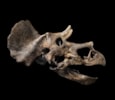Juvenile Triceratops Skull
Juvenile Triceratops Skull
Maastrichtian, Late Cretaceous Period (68-66 Million Years Ago)
Fossilised Bone
H:210 x W:75 x D:103 cm
Sold
Roaming the earth some 68 million years ago, this fossilised triceratops skull comes from a rare juvenile specimen. The skull bones of a juvenile triceratops were not fully knitted together, the faces and frills were both short, and the eyebrow horns curved backward toward the frill. A ridge of ‘epoccipital’ bones, which are the small triangular bones along the top edge of the frill are much more distinct in younger triceratops, and remain as individual small bones until adulthood.
Subadult and adult skulls were not only much larger, being over one-third of their entire body length, but the bones fused, the face and frill lengthened, and the horns began pointing forward.
The skull of this juvenile measures circa 100cm in length, half the size of a fully developed adult triceratops skull.
Since the triceratops' discovery in 1887, up to 16 species of the dinosaur have been proposed, but only two species T. horridus and T. prorsus are currently considered valid. It was originally thought that baby and juvenile examples were of a different species due to the disparity in bone structure and the distinct rarity of juvenile remains, it is now known that the skull changed significantly during age development.
A growth series of 5 triceratops skulls represents four growth stages: (a) baby, (b-c) juvenile, (d) subadult and (e) adult
In 2006, the first extensive ontogenetic study (the study of the developmental process) of triceratops was published and found that triceratops could be divided into four general ontogenetic groups: babies, juveniles, subadults, and adults. With a total number of 28 skull specimens studied, the youngest was only 38 centimetres long. Each of the four growth stages was found to have identifying features. Multiple trends were discovered relating to the ageing process, including the size reduction, and fusing of the pointed bones lining the frill, development and reorientation of fore brow horns, and hollowing out of the horns.
Unfortunately, these small triangular epoccipital bones are missing from our example, however, from other distinctive traits and the reduced size, we can surmise that this is an excellent example of a highly complete skull of a juvenile triceratops.
Discovered on private land belonging to Verlin R Steppler and Cody J Steppler in September 2021, and excavated in Montana, USA, coordinates 47.86405, -105.90068.
ALR: S00225158, with IADAA Certificate, this item has been checked against the Interpol database.










 Enquire
Enquire




